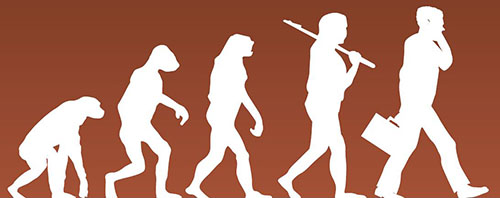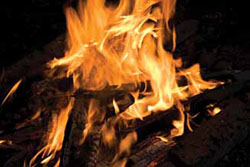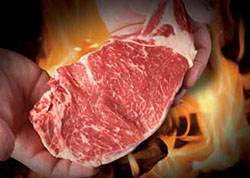
Management 101 The “Real” Beginning


By Patrick Kinane
Warning: Dilbert inspired this article. Although derived from real situations, this is a fictional story. To all managers or wannabe managers, Dilbert is NOT a guide book and should not be read by those who believe so. The processes mentioned in this article were performed by professional fools, and should not be duplicated in the workplace by amateur fools.
Everything has a beginning, including management. Texts and academia have tracked the origins of management to the industrial revolution — however, my research has shown it has its true origins in the Stone Age.
Eg, Mg and QA
Recent cave drawings have revealed some startling facts through a story line about three cave people — Eg, Mg and Qa. Qa is from France. More than 100,000 years ago, our human ancestors were happy hunter-gatherers. They would spend days roaming in the pristine meadows and forests. At the end of the day, they would all share in the raw fruits and vegetables they gathered. They would skin local buffalo for their fur and throw the meat away. (Steak tartar wouldn’t be invented for another 75,000 years). They didn’t have a worry except for the occasional ice age that would force them to vacation on the Mediterranean coast — so even that wasn’t so bad.
Then, one dark and stormy day, Eg, one of the cavemen, was out on his morning jog before breakfast when he came across an old dried-out tree that had been struck by lightning. He was startled at the sight of the tree which was aflame with …. well, a flame. Eg brought one of the flaming sticks back to the cave to show everyone. He introduced the stick to everyone, stating he designed it and he was going to call it Eg (but figured that was too pretentious) so he called it “fire.” We will from now on call Eg an engineer. This newly-discovered fire brought light to the darkness, warmth to the cold and added a new step in food processing. Unknown to Eg, and the rest of the cave dwellers, a profound change to mankind was taking place.
Playing with fire
 With fire, the cave dwellers now had light so they could skin animals in the evening. One evening, while skinning an animal, one of the cave dwellers dropped a piece of meat in the fire. For fear that he would get blamed if the meat ruined the fire, he pulled that piece of meat out of the fire. In order to get rid of the evidence, he put it in his mouth. With a mouth full of food he mumbled, “Wow! This is good.” The fire had changed the taste of the food. Before long, everyone was putting their meats and vegetables on a stick and holding it over the flame. When the vegetables and meat were combined, the shish kebab (cave for vegetables and meat on a stick) was introduced to the world.
With fire, the cave dwellers now had light so they could skin animals in the evening. One evening, while skinning an animal, one of the cave dwellers dropped a piece of meat in the fire. For fear that he would get blamed if the meat ruined the fire, he pulled that piece of meat out of the fire. In order to get rid of the evidence, he put it in his mouth. With a mouth full of food he mumbled, “Wow! This is good.” The fire had changed the taste of the food. Before long, everyone was putting their meats and vegetables on a stick and holding it over the flame. When the vegetables and meat were combined, the shish kebab (cave for vegetables and meat on a stick) was introduced to the world.
Unfortunately, fire added some complication to the otherwise happy life of the cave people. They were confronted by change, and not everyone readily accepted this new concept. But after tasting the food-over-flame (the term ‘cooking’ wasn’t used until the middle ages), most of the skeptics were converted.
Management steps in
 Mg, another cave person, was one of those converts. He noticed that the sticks used in food-over-flame were also the fuel used to keep the flame going. This didn’t make sense to him because he was always looking for ways for others to be efficient. Taking the inspirational words, “Do more with less,” from one the ancient leaders literally, Mg decided to do away with the stick and hold the food over the flame with his hand. This hurt tremendously. No matter how hard he tried, he could not hold the food long enough to complete the food-over-flame process.
Mg, another cave person, was one of those converts. He noticed that the sticks used in food-over-flame were also the fuel used to keep the flame going. This didn’t make sense to him because he was always looking for ways for others to be efficient. Taking the inspirational words, “Do more with less,” from one the ancient leaders literally, Mg decided to do away with the stick and hold the food over the flame with his hand. This hurt tremendously. No matter how hard he tried, he could not hold the food long enough to complete the food-over-flame process.
Seeing that this process presented a problem that he could neither do himself or solve, he instructed the clan that they must throw their stick in the fire and hold all food with their hands, thus fulfilling the law of “Do more with less.” We’ll call Mg a manager.
The clan was having an extremely difficult time completing the food-over-flame process without sticks and suffered many injuries. Numerous safety grams and grievances from the Dwellers Amalgamated Motivational Nation were filed to no avail, since a viable management structure had not yet been invented. The clan became discouraged and morale was adversely affected because they could no longer complete the food-over-flame that they learned to love.
Attempts to fix the process
Mg blamed the failure to complete the food-over-flame process on the clan, saying they refused to follow standard operating procedures and they were the cause of the increased injury rate and poor food-over-flame process. Qa, a self-proclaimed cave policeman who reported to and was paid by Mg, audited the process and confirmed that the food did not meet the heat requirements of the newly-formed Consolidated Regional Approval Program and the Joint Uber Nacht Klan could not be certified.
After months of analysis, Qa found that the reason the food did not meet the heat requirement was due to the fact that it wasn’t over the flame long enough. This is also the first recorded (cave art) use of the word ‘duh,’ uttered by many members of the Joint Uber Nacht Klan.
Qa realized this did not become a problem until the elimination of the sticks. A process change had taken place. He knew that progress always goes forward and the clan could not go back to using sticks. Qa concluded that to reach the proper heat range, the food must be held over the flame longer. This circular logic would become the foundation of many modern-day company policies.
The cave art goes deeper in how the simple process was standardized into complicated instructions. Some safety rules were set in place, and many attempts at efficiency were developed. One was ‘lean.’ All meat was to be lean meat since two northern caves blew up, throwing fat in the fire.
There are also rock carvings of ‘six-cowsigmarouge,’ a development from a consulting company started by Qa which is used to measure the redness of food-over-flame meat for better control. In excess of negative six-cowsigmarouge, the meat would be too raw to eat. More than positive six-cowsigmarouge, and the meat could not be eaten, but was instead used as a hockey puck. The cave dwellers previously used rocks for hockey pucks, but the meat cinder slid better on the rink. It wasn’t until the late 20th century that six-cowsigmarouge was rediscovered and the name shortened dropping the “cow” and “rouge” so it could be claimed as a new invention.
So you see that modern business concepts did not have their beginnings during the industrial revolution as many text books would lead you to believe — their origins go much further back in time.
 Patrick Kinane is a regular contributor to D.O.M. magazine (www.dommagazine.com). Kinane joined the Air Force after high school and has worked in aviation since 1964. Kinane is a certified A&P with Inspection Authorization and also holds an FAA license and commercial pilot certificate with instrument rating. He holds a B.S. in aviation maintenance management, MBA in Quantitative Methods, M.S. in education and PhD in organizational psychology. The majority of his aviation career has been involved with 121 carriers where he has held positions of aircraft mechanic, lead mechanic, maintenance supervisor, maintenance and operations manager, station manager, maintenance training manager, quality and safety systems auditor and director of maintenance. Kinane currently works as an adjunct professor for DeVry University instructing in total quality management (TQM) and critical thinking. PlaneQA is his consulting company that specializes in quality and safety system audits and training. Speaking engagements are available with subjects in critical thinking, quality systems and organizational culture and climate. For more information, visit www.PlaneQA.com.
Patrick Kinane is a regular contributor to D.O.M. magazine (www.dommagazine.com). Kinane joined the Air Force after high school and has worked in aviation since 1964. Kinane is a certified A&P with Inspection Authorization and also holds an FAA license and commercial pilot certificate with instrument rating. He holds a B.S. in aviation maintenance management, MBA in Quantitative Methods, M.S. in education and PhD in organizational psychology. The majority of his aviation career has been involved with 121 carriers where he has held positions of aircraft mechanic, lead mechanic, maintenance supervisor, maintenance and operations manager, station manager, maintenance training manager, quality and safety systems auditor and director of maintenance. Kinane currently works as an adjunct professor for DeVry University instructing in total quality management (TQM) and critical thinking. PlaneQA is his consulting company that specializes in quality and safety system audits and training. Speaking engagements are available with subjects in critical thinking, quality systems and organizational culture and climate. For more information, visit www.PlaneQA.com.
